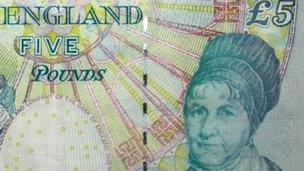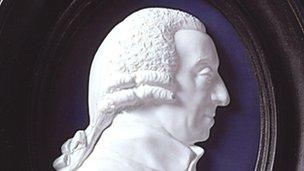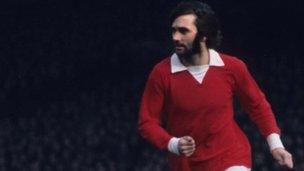The historical characters on our banknotes
- Published
We are likely to see many of their names and faces every day, but how much do we know about the historical characters on our banknotes?
As of 2 November, Matthew Boulton and James Watt have joined the range of people from the past whose portraits are found on the pound.
Following a long process of selection, design and manufacture, the new £50 banknote is in circulation, with the industrialist and engineer as the first dual portrait produced on a Bank of England note.
In time they will replace Sir John Houblon, the first governor of the Bank of England, as the faces of the £50 note.
So who can we find on our banknotes, and why have they been picked?
The newcomers
Anyone lucky enough to get their hands on a £50 will - on the newest notes - find the portraits of industrialist Matthew Boulton (1728-1809) and James Watt (1736-1819).

Boulton (left) and Watt were two key figures in the Industrial Revolution
The former, as an entrepreneur, was key to the emergence of Birmingham as a centre for manufacturing.
Meanwhile, Watt was an engineer and scientist who improved the steam engine and, encouraged by Boulton, made one for the textile and cotton spinning industry.
He introduced the term "horsepower" and the metric unit of power is named after him.
The reason both appear on the £50 note is that their partnership brought steam-driven machinery to the minting of coins.
Boulton established the Soho Mint, to support the Royal Mint, and produced coins of the highest quality.
Chris Salmon is chief cashier at the Bank of England and his signature goes on the new bank note
Also appearing on the £50 note - the first time he appears on any banknote - is Chris Salmon.
While you will not see a portrait of him, his signature will become one of the most common and important in the country.
That is because he is the chief cashier of the Bank of England, and without the signature of the person in that position on a Bank of England banknote, it is not legal.
The Bristol University graduate joined the Bank of England in 1991 and took up his current role in April. His name replaces that of previous chief cashier Andrew Bailey - whose signature still appears on most banknotes in circulation.
The current crop
Some of the characters whose portraits can be found on Bank of England banknotes are household names but others, even though we see their pictures so regularly are not.

Social reformer Elizabeth Fry was the daughter of a banker from Norwich
Take the face of the fiver - Elizabeth Fry (1780-1845).
She was the third daughter of Norwich banker John Gurney, who made her name as a social reformer.
Her influence on prison reform spread around the world. The portrait on the £5 note was from the time she was awarded the key to Newgate Prison in recognition of her work, especially in improving the conditions for women prisoners.
Perhaps much better known is Charles Darwin (1809-1882), the British scientist who laid the foundations of the theory of evolution and transformed the way we think about the natural world.
The £10 note features HMS Beagle, the vessel on which Darwin collected a mass of specimens and notes from which he drew his most significant conclusions.
Rising up the value chart, and onto the Bank of England £20 note, we can find one of the fathers of modern economics, Adam Smith (1723-1790).

The picture of Adam Smith on a £20 note was adapted from this image in the National Galleries of Scotland
His theory of the division of labour, outlined in An Inquiry into the Nature and Causes of the Wealth of Nations, has become fundamental for industry and commerce.
Using an example of a pin factory, he explained how co-operation between workers in the factory, dividing tasks between them, raised their collective output.
Until recently composer Edward Elgar featured on the £20 note, but these banknotes no longer had legal tender status after 30 June 2010.
Sir John Houblon (1632-1712) features on the £50 note which will eventually be phased out as it is replaced by the Boulton and Watt version.
He was the first Governor of the Bank of England and the £50 note on which he appears was issued in 1994 - the 300th anniversary of the Bank.
The design on the back of the note includes an image of Houblon's house in Threadneedle Street, on the site of the bank's present building in the City of London.
Scottish and Northern Irish banknotes
Three banks in Scotland and four in Northern Ireland are authorised to issue banknotes.

A limited edition of one million £5 notes featuring George Best sold out in 10 days
While Bank of England notes are generally accepted throughout the UK, there have been cases of some traders outside Scotland turning down the use of Scottish notes.
Northern Irish banknotes are rarely seen outside Northern Ireland.
What the numerous different notes have created is an opportunity for many more historical figures to appear on banknotes in the UK, and even some more contemporary personalities.
Two series of Bank of Scotland banknotes, which include a £100 note, feature the portrait of Sir Walter Scott (1771-1832).
He wrote a series of public letters under the pseudonym of Malachi Malagrowther which led a campaign against currency reform and meant the pound note was retained in Scotland.
On notes issued by Clydesdale Bank, there is a portrait of pharmacologist Sir Alexander Fleming, poet Robert Burns and King of the Scots Robert the Bruce.
One note features Elsie Maud Inglis, who helped send 1,000 women doctors, nurses and drivers across Europe in World War I. On others, is artist Charles Rennie Mackintosh. Missionary Mary Slessor and researcher and inventor Lord Kelvin also appear.
The most prominent portrait on the Royal Bank of Scotland notes is the bank's first governor Lord Ilay.
In Northern Ireland, tyre inventor John Boyd Dunlop, Harry Ferguson - who was influential in the development of the tractor - Samuel Cleland Davidson, inventor of tea processing machinery, and aircraft manufacturer Sir James Martin all appear.
Commemorative banknotes have appeared in Scotland and Northern Ireland.
Three times Open Golf Championship winner Jack Nicklaus made it onto a £5 note. Football great George Best also appeared on a £5 note and it proved so popular that the limited edition of one million sold out in 10 days.
Those who did not make it
The Bank of England publishes a list , externalof the names of people who the public deem to be suitable for appearing on banknotes.
Some of those who have been nominated, but have yet to make the grade, are David Beckham, Princess Diana and Sir Terry Wogan.
Historical nominations include Jane Austen, Oscar Wilde and Admiral Lord Nelson.